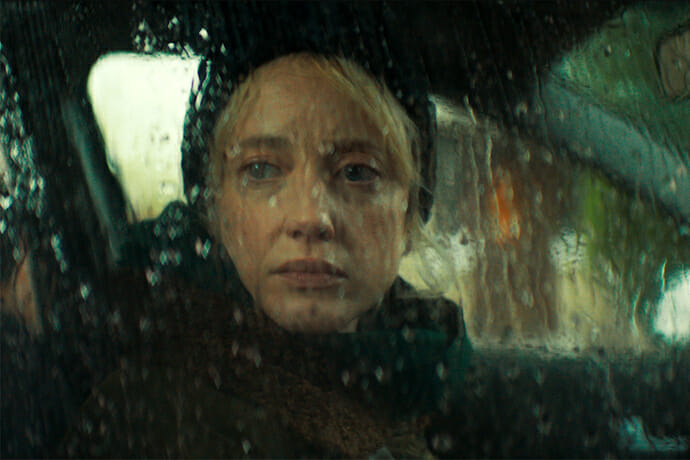
SXSW 2021 Day 2
Read David Ferguson’s review of day 1 here.
This year’s South By Southwest (SXSW) festival is being held completely online, and of course a virtual festival lacks the oh-so-enjoyable elements of long lines, rude people, bad weather, and rushed fast food. Sure the excitement and energy of an audience is missing, but at least there is no hotel expense!
Day 2 for me included two documentaries, two thrillers, and two dramas. Here’s a recap:
WeWork: Or the Making and Breaking of a $47 Billion Unicorn (documentary)
It’s quite possible that many scams originally begin with someone’s good intentions. However it’s just as likely, and maybe even more so, that many scams begin with only the intention of raking in millions or billions for the founder. The dream of becoming the next Steve Jobs, Jeff Bezos, or Mark Zuckerberg is simply too enticing for some. Filmmaker Jed Rothstein profiles the rise and fall of WeWork, or more accurately, its charismatic commander, Adam Neumann.
Offering a nice overview for those unfamiliar, the film uses multiple clips of Neumann speaking so that we get a real feel for how so many fell under his spell. Neumann was an immigrant from Israel and certainly bought into the ideal of living the American Dream. Labeled a visionary, and always full of ideas, Neumann co-founded WeWork with Miguel McKelvey. They were known affectionately as Mr. Outside and Mr. Inside, respectively, due to McKelvey’s focus on operations and infrastructure and Neumann’s ability as a salesman and the (and hair) of the company.
The idea of co-working space was not new, but it had never been pitched or marketed the way that Neumann did. He appealed to the rebellious nature of millennials, who couldn’t picture themselves in the traditional corporate office environment of the establishment. Neumann capitalized on their FOMO, and rammed home the message of “Do what you love.” He preached to the choir with his promise of the next revolution being the “We revolution.”
Journalists from Forbes, The Atlantic, and The Wall Street Journal are interviewed, as are former We staff members and clients. Mr. Rothstein does a nice job of tracking the progression of the company via graphics showing valuation each year beginning with a few million in 2012 through a peak of $47 billion in 2018. He also explores how, within a 6-week period, the company went from that peak to nearly bankrupt.
A business model based on “community” with the goal of changing the way people work and live, turns out to be smoke and mirrors if legitimate business practices aren’t followed. That’s not to say his communal approach doesn’t work, but as so often happens, greed and the lust for power, create the downfall. Rothstein points out that the company’s own S-1 filed prior to the planned IPO was the red flag that had previously gone undetected.
This is as much a psychological study of Neumann as it is a business case study. Every time Neumann bristled at being called a “real estate company,” we should have known. With his cash infusion from Japan’s SoftBank still not leading to traditional profitability, we should have known. When his bizarre actress wife, Rebekah, became more involved with decisions and publicity, we should have known. Hindsight is crystal clear, and by the end, we realize Neumann has more in common with the notorious Elizabeth Holmes of Theranos than with Steve Jobs. The Jesus Complex seems obvious, but as humans we want so much to believe the words of an idealist…especially a cool one. There is a lot to unpack in this documentary, and it’s worth it – even if it helps us learn our lesson yet again.

Grief can be the most powerful and dangerous emotion we experience as humans. Anger and joy come and go, but real grief seeps into our marrow and becomes part of our being. Writer-director Stacey Gregg wisely tackles the topic with the assistance of the always-excellent Andrea Riseborough (a resume loaded with strong projects) as Laura, a mother who begins to believe that her deceased daughter Josie has been reincarnated as the new neighbors’ daughter, Megan (Niamh Dornan).
Ms. Gregg expertly builds tension and doubt through the film’s first half, and throws a terrific curveball in the final act…one I kick myself and applaud the filmmaker for not seeing it coming. There is an awkwardness between the two families forced together by a shared dwelling wall. That awkwardness only builds as Laura continually oversteps boundaries when it comes to Megan, who seems to know entirely too many details when it comes to Josie’s death.
Megan’s parents, Marie (Eileen O’Higgins) and Chris (Martin McCann), are from a different socio-economic class than their neighbors, and the uncomfortable connection extends to Laura’s husband, Brendon (Jonjo O’Neill), and son, Tadhg (Lewis McAkie). Whether it’s in the front yard, at school, or the grocery store, each time these families cross paths leaves us with weird vibes and feeling more confused. Is something supernatural at play here?
The cinematography from Chloe Thomson is superb, and composer Adam Janota Bzowski is pitch-perfect in giving us just enough at the right moments. Set in Belfast, this is a gripping thriller with terrific performances throughout. Stacey Gregg makes it look all too easy with her first feature film.
Language Lessons
The use of video chats as a plot device might have been a bit more adventurous 18 months ago, but oddly, the pandemic and our familiarity with this type of communication (out of necessity) actually works to strengthen this interesting film.
It’s the feature film directorial debut of Natalie Morales, who co-wrote the script with Mark Duplass, and the two co-star as the only characters we see on screen.
Ms. Morales plays Carino, a Costa Rica-based Spanish teacher hired by Adam’s (Duplass) husband Will (an unseen DeSean Terry). An awkward first lesson – Lesson #1 of 100 in the package – includes Adam’s morning routine of hot/cold dips in the pool and spa in the backyard of his luxurious home. Director Morales labels the lessons throughout, and no, we thankfully don’t see all 100. After a personal tragedy occurs, the teacher-student dynamic shifts and becomes more therapy before settling into a strange friendship.
Between lessons, Adam and Carino exchange many personal messages, many littered with entirely too many “I’m sorry” lines in an attempt to avoid overstepping boundaries. Adam is forthcoming with his personal feelings, while Carino bounces between trying to stay professional and wanting to bond. It’s clear she is hiding details of her personal life, while rarely discouraging Adam from over-sharing. The frequent personal messages reveal more about each character than the scheduled meetings but combined they work very well.
The charisma of Duplass and especially Morales allow us to care very much about this relationship. They are both charming, and Morales has the most fun in the drunk birthday song scene. She is to be commended for taking such a simple structure and creating an interesting movie that proves people need connection – whether in person, through masks, or via Zoom.
The Fallout
Megan Park is an established actress with some memorable roles (What If, 2013), and although she has directed some short films, this is her first feature film as a writer-director. Her subject matter revolves around a school shooting and how it impacts students in so many ways. Rather than creating a project focusing on gun control, Ms. Park instead takes on the various emotions that occur after such a horrific event.
Vada (Jenna Ortega, young Jane in “Jane the Virgin”) is a 16-year old high school student who is in the restroom when gunfire is heard. We don’t see the shooter, and instead, director Park sticks with Vada and Mia Reed (Maddie Ziegler) as they hide in the stall, terrified of what’s happening. Mia is the school beauty, and one that Vada and her best friend Will (Nick Ropp) would typically make fun of behind her back. While in the stall, a bloody Quinton (Niles Fitch) joins them.
The three students form an unlikely bond after the shooting, as Will finds a new mission in life as an activist and spokesperson. Vada’s parents are played by a skittish Julie Bowen and the always dependable John Ortiz. Vada and Mia both struggle with their emotions and start to depend on each other. Quinton has serious fallout to deal with, though he and Vada get closer as well. Though she is unable to talk to her parents or deal with her younger sister, Vada does see a therapist played by Shailene Woodley.
It’s painful to see anyone have to deal with such a horrific event, but it’s so much worse when it’s kids who simply aren’t mature enough or experienced enough to handle such a burden. Wine, sex, and pot all make up the attempts at self-healing by the students, and the film doesn’t shy away from the difficulties they face in returning to school – or returning to anything resembling normalcy after attending memorial services for numerous classmates. Filmmaker Park allows us to experience Vada’s slow recovery and then throws in a gut-punch of an ending that is likely to stun many. A terrific performance from Ms. Ortega and strong filmmaking from Ms. Park makes this one stick with us.

Adria Petty, daughter of the late rock legend, Tom Petty, discovered a stash of 16mm film shot by photographer Martyn Akins between 1993 and 1995. The footage chronicles Petty’s recording of his 1994 triple-platinum album, “Wildflowers” – the album he considered his best and most personal. The found footage, along with insight and perspective from many who were there, allows us to understand why he felt that way.
Mary Wharton directed multiple episodes of “VH1 Legends,” and her expertise with musicians elevates this to a must-see for any Tom Petty fan…or even any songwriter who wants to witness the crafting of songs, and the crafting of a sound.
See, this was Petty’s first time working with famed rap producer and co-founder of Def Jam Recordings, Rick Rubin. Adria explains what was happening in her father’s personal life during this time, and how he wanted something new and different from his work with The Heartbreakers – although most of them worked on this album as well.
In addition to the 27-year-old footage, Ms. Wharton includes current-day interviews with Mike Campbell, Benmont Tench, and producer Rubin. Campbell seems mostly bored with the interviews, but Tench spills all his memories. It’s really Rubin who brings the most insight and perspective to what Petty was trying to do. The changing of drummers from Stan Lynch to Steve Ferrone is discussed, and we hear Petty explain that he still wants to sing with bassist Howie Epstein. So the songs may sound different and have special meaning to Petty, many of the musicians are those he was most familiar and comfortable with.
We see rehearsals, recordings, sound checks, and live performances. There are also rare clips of Petty at home. Ms. Wharton provides a unique opportunity to watch an artist at work and how the pieces are assembled to create a masterpiece album that is as strong today as it was on its first release. Tom Petty died in 2017 but lives on in his music, and now in the footage of his musical process.
Offseason
Horror director and writer Mickey Keating adds to his oeuvre with a creative twist on the genre that mixes zombies, the depths of hell, and a powerful monster. Using title cards to take us through six chapters and an Epilogue, Mr. Keating has us experience the events through the eyes of Marie Aldrich (played by Jocelin Donahue). However, it’s Marie’s mother Ava, played by the always interesting Melora Walters (whose career dates back to Dead Poets Society, 1989), whom we see and hear from first. She appears near death as she explains that she’s accepted that there is no way to run away from nightmares…they always find you.
Marie receives a letter informing her that her mother’s grave has been desecrated and it’s an urgent matter that must be handled promptly and without fanfare (do people usually go to the press on such matters?). Marie and her boyfriend George (Joe Swanberg) head to the island where Mom is buried. It’s a creepy place that shuts down for the winter. Marie’s mother had told her stories of the island and “The Man from the Sea,” and how the island residents sold their soul to the sea monster in order to survive the harsh conditions. Reluctantly, the Bridge Man (Richard Brake) allows them to cross the bridge onto the island.
Things immediately seem weird and off-center. Marie finds her mother’s damaged grave, but the caretaker is nowhere to be found. Under a time crunch, Marie and George make some bad decisions…of course, it wouldn’t be a horror movie without bad decisions! Not to give away any of the fun, but suffice to say the island is cursed, just as Marie’s mom had warned.
Keating creates some nice visuals, and has terrific placement of The Vogues’ “Turn Around, Look at Me”. One thing that I couldn’t help but notice is that Marie runs and runs. She runs a lot. I’m hoping Ms. Donahue agreed to the extra miles before arriving on set. There are enough chills here to keep us engaged, and Keating deserves credit for an original story within a genre that frequently re-treads.

